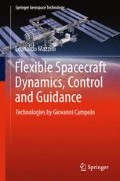Abstract
The mass ejection systems called also propulsion systems are used both for attitude and orbit control. The propulsion systems currently available or in development operate using a wide spectrum of propulsion methods. In this chapter we review the main propulsion systems with a specific attention to chemical and plasmic propulsion. The theory of these propulsion systems is explored in order to characterize the main performance parameters at system level.
Access this chapter
Tax calculation will be finalised at checkout
Purchases are for personal use only
Notes
- 1.
We note that dinitrogen tetroxide, N\(_2\)O\(_4\), is also indicated as nitrogen tetroxide, NTO.
- 2.
The microwave range is usually referred to as that between 0.3 and 300 GHz. Typically, those used in these thrusters are UHF (ultra high frequency, in the range between 0.3 and 3 GHz (decimeter waves), and SHF (super high frequency), in the range between 3 and 30 GHz.
- 3.
The frequency beyond which the wave becomes evanescent is called the cutoff frequency.
- 4.
The Larmor radius of ions is much larger than that of electrons, thus as a first approximation the magnetic force on ions can be neglected.
References
H. Nguyen, J. Kohler, L. Stenmark, The merits of cold gas micropropulsion in state of the art space missions, IAC-02-S.2.07
M.J.L. Turner, in Rocket and Spacecraft Propulsion: Principles, Practice and New Developments, 3rd edn., Springer-Praxis Series in Astronomy and Space Science, ed. by M.J.L. Turner (2009)
D.M. Goebel, I. Katz, Fundamentals of Electric Propulsion: Ion and Hall Thrusters, vol. 1 (Wiley, Hoboken, 2008)
H.R. Kaufman, An Ion Rocket with an Electron-Bombardment Ion (NASA Technical Note, D-585, 1961)
J.S. Sovey, Improved ion containment using a ring-cusp ion thruster. J. Spacecraft 21, 488–495 (1984)
L. Mazzini, V. Tamilia, The Artemis satellite unexpected trip to GEO Orbit. Space Technol. 24(1), 43–56 (2004)
Author information
Authors and Affiliations
Corresponding author
Rights and permissions
Copyright information
© 2016 Springer International Publishing Switzerland
About this chapter
Cite this chapter
Mazzini, L. (2016). Spacecraft Propulsion. In: Flexible Spacecraft Dynamics, Control and Guidance. Springer Aerospace Technology. Springer, Cham. https://doi.org/10.1007/978-3-319-25540-8_8
Download citation
DOI: https://doi.org/10.1007/978-3-319-25540-8_8
Published:
Publisher Name: Springer, Cham
Print ISBN: 978-3-319-25538-5
Online ISBN: 978-3-319-25540-8
eBook Packages: EngineeringEngineering (R0)

